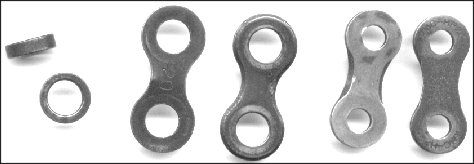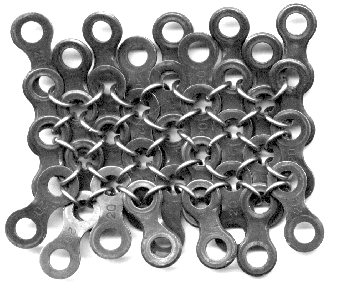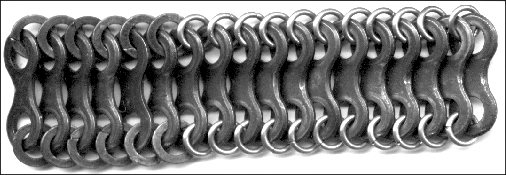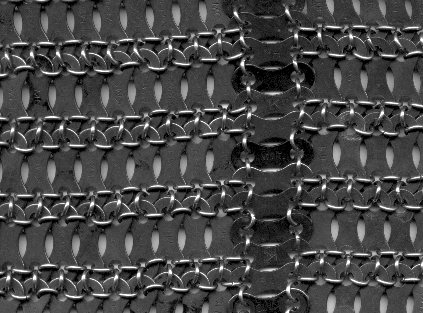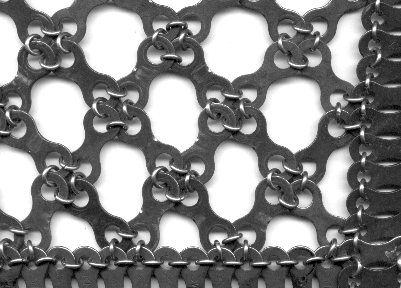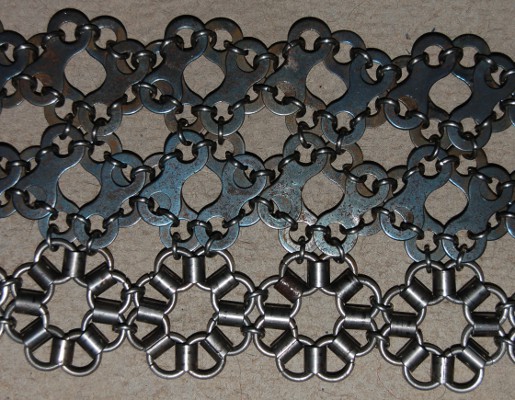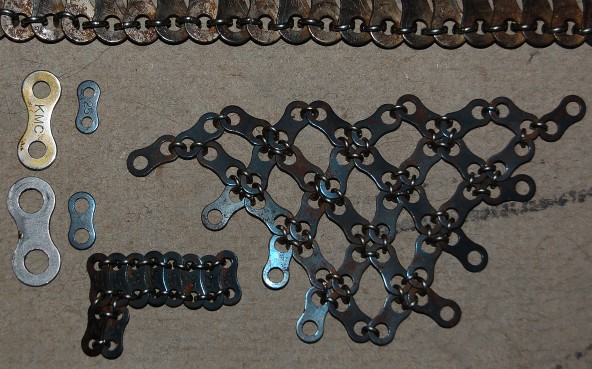|
One more thing I have to mention about bikechains... a bike chain is a type of chain called roller chain, which can be found in several sizes. "pitch" is the most commonly used term to describe the size and is a measurement of the distance between the centers of the pins in the chain. Bicycle chains have a pitch of .5". I've seen roller chains with a 1" pitch (which might be what is used on motorcycles), 5/8" pitch, 3/8" pitch (I have one foot of this type, but have not had a chance yet to play with it), and 1/4" pitch (the size some large film projectors use, I've used some of this size for a very fine laticework weave and a small sample of the other jap4-1 that's really jap3-1). Most of the half inch pitch chains I'm trying to find now are the type from exercise bikes. These ones seem to be the ones with the most consistant shape and color, which is good if your working on a clothing sort of project and need to scrounge up a dozen or so chains.
Pop-Tab Maille

| These are the same basic sort of shape as roller chain links, that is to say that they are a metal plate with two holes. A pretty basic shape. The two major cola companies, which is where most of these come from, each use slightly different shapes.. and I think I've seen some other odd shapes on a few other cans. Some products of these companies make their cans a bit more distinctive and eye catching by anodizing their aluminum tabs. I have seen them in yellow-green, blue, and red... I'm sure there are, or will be other colors... I have fond memories of diving into a bearproof dumpster somewhere in the Canadian Rockies because I saw a can with a bright blue tab. This sample of tab-maille is just one of many weaves (how many? I have no idea...) possible with these tabs. The special thing to take note of in this pic is that the lower half of the patch is made from slightly larger rings than the upper half. This allows for some tailoring, without using funky things like idle rings and odd angles.. which would work with normal maille, even works to some degree with links from roller chain, but I've found tabs to be too big and bulky for those techniques... but a slight increase in ring sizes for a few rows at the edges will cause the sides to flair out a bit, which could be usefull if making a corset type of thing... or a couple rows of smaller rings along the bottom of a wide strip could contract the weave enough along the bottom to make something that would work as part of a haltertop sort of garment.
|
Round discs or Coins
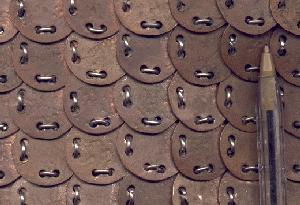
| This is an old scan of a my first experiment in the late 1990's with maille and something else joined together as a new form of maille. This one is made from flattened pennies with eight holes punched along the sides. It's a maille weave based on lammelar, which was a type of armor made of metal plates held together by laces woven through holes at the edges of the plates. In this case, I used maille rings (stainless, .045" wire, ~1/8" ID) in place of lacing. The holes were punched with a whitney style metal hand punch, and placement of the holes had to be very precise for the plates to overlap just the right amount... if they were a little off the the edges of the plates that are diagonal from each other would overlap and make the weave inflexable; or the plates diagonal from each other would have gaps between them, making the weave look to open and sloppy. Also, if you want to see more examples of maille made with coins, find your way through this website to the page with sculptural things and maille balls... near the bottom of that page there are some maille balls made partly with coins.
|
|
